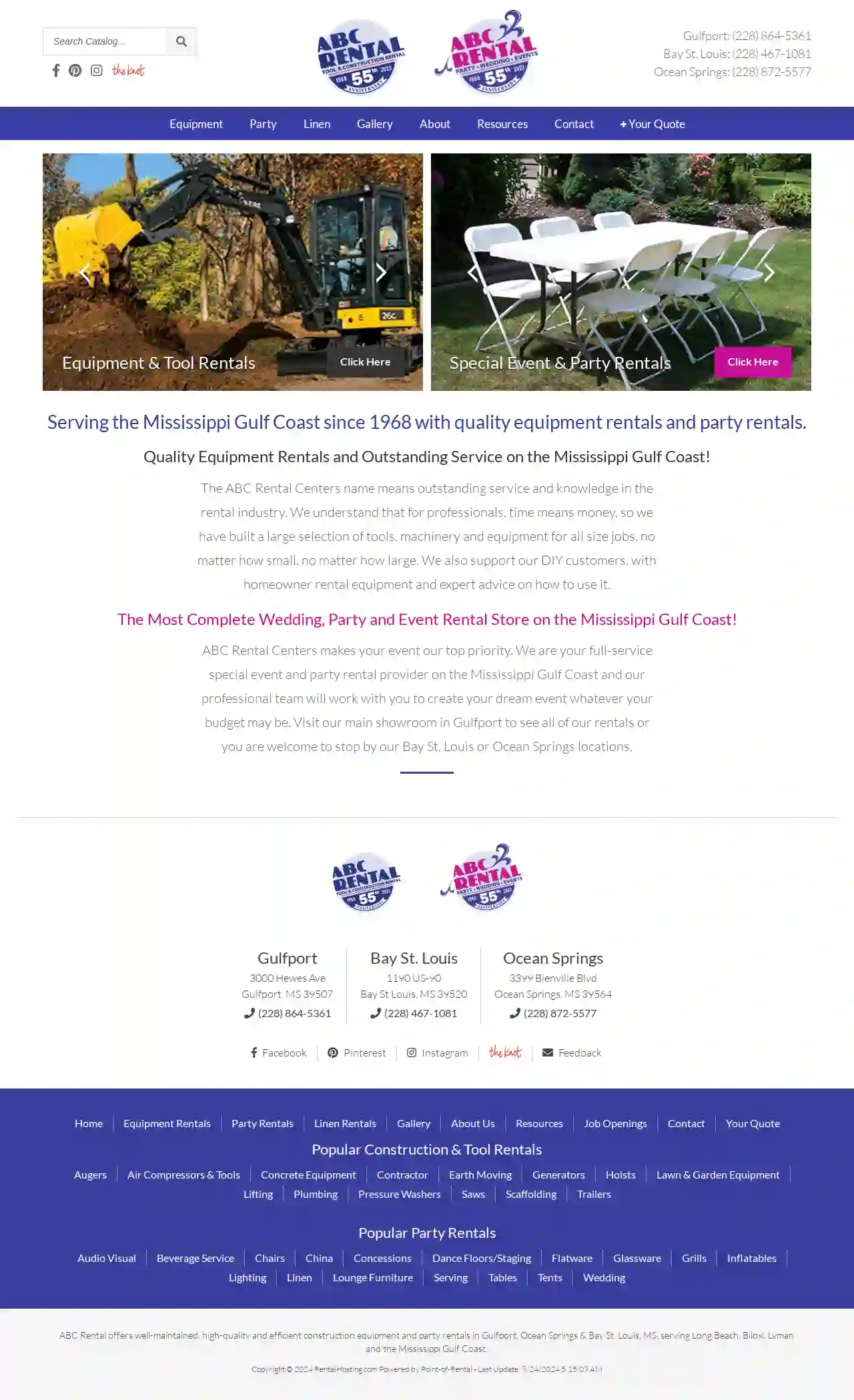Scaffolding Companies Florence
Find top Scaffolding Solutions in Florence
Get 3 FREE Scaffolding Specialists quotes for your project today! Compare profiles, reviews, accreditations, portfolio, etc... and choose the best service.
Service Needed
City or Town

ABC Rental Center
4.4151 reviews3000 Hewes Ave, Gulfport, 39507, USABC Rental offers well-maintained, high-quality and efficient construction equipment and party rentals in Gulfport, Ocean Springs & Bay St. Louis, MS, serving Long Beach, Biloxi, Lyman and the Mississippi Gulf Coast. With a wide range of equipment and party rentals, ABC Rental is dedicated to providing outstanding service and knowledge in the rental industry.
- Services
- Why Us?
- Gallery
Get Quote- Ma
Magnolia Masonry of South Mississippi LLC
4.914 reviewsGulfport, US- Services
- Why Us?
Get Quote - Lo
Lowe's Home Improvement
4.1Gulfport, US- Services
- Why Us?
Get Quote - Th
The Home Depot
4.2Gulfport, US- Services
- Why Us?
Get Quote - Cr
Crom Equipment Rentals Inc
Gulfport, US- Services
- Why Us?
Get Quote
Over 2,353+ Scaffolding Businesses in our network
Our scaffolding contractors operate in Florence & surrounding areas!
ScaffoldingHQ has curated and vetted the Best Scaffolding Businesses arround Florence. Find a reliable contractor today.
Frequently Asked Questions About Scaffolding Companies
Find answers to common questions about scaffolding companies and hiring scaffolding contractors in the USA.
- Traditional and highly versatile.
- Components (tubes, clamps, boards) are assembled on-site.
- Adaptable to complex shapes and structures.
- Requires skilled labor and more time for erection.
- Pre-engineered, modular components.
- Faster and easier to erect.
- Often has higher load capacities.
- May be less versatile for complex shapes.
- Workers: Consider the number of workers on the scaffolding at any given time.
- Materials: Include the weight of building materials, tools, and equipment being used on the platform.
- Environmental Factors: Factor in potential loads from wind or snow, especially for taller scaffolding structures.
- A temporary structure with a larger platform for workers and materials.
- Offers greater stability and working space.
- Suitable for tasks requiring movement and multiple workers.
- Used for higher elevations and more complex projects.
- Used for reaching specific points at height for short durations.
- Less stable than scaffolding, requiring more caution and balance.
- Not suitable for tasks involving heavy materials or extended work periods.
What is the difference between tube and clamp scaffolding and system scaffolding?
The two main types of scaffolding systems have distinct advantages and disadvantages:
Tube and Clamp Scaffolding:
Tube and Clamp Scaffolding:
Can I erect scaffolding myself?
While it might seem tempting to save money, it's strongly recommended NOT to erect scaffolding yourself unless you are a trained and competent scaffolding erector. Scaffolding erection requires specialized knowledge, skills, and tools to ensure safety and structural stability. Incorrectly erected scaffolding can lead to serious accidents. Always hire a qualified and experienced scaffolding company to handle the installation and dismantling of scaffolding.
What is the weight limit for scaffolding?
The weight limit for scaffolding varies depending on the type of scaffolding, its design, and the materials used. The scaffolding should have a load capacity that safely accommodates the combined weight of:
What is the difference between a scaffold and a ladder?
While both provide elevation for work at height, they differ significantly:
Scaffolding:
Scaffolding:
What is the difference between tube and clamp scaffolding and system scaffolding?
The two main types of scaffolding systems have distinct advantages and disadvantages:
Tube and Clamp Scaffolding:
Tube and Clamp Scaffolding:
- Traditional and highly versatile.
- Components (tubes, clamps, boards) are assembled on-site.
- Adaptable to complex shapes and structures.
- Requires skilled labor and more time for erection.
- Pre-engineered, modular components.
- Faster and easier to erect.
- Often has higher load capacities.
- May be less versatile for complex shapes.
Can I erect scaffolding myself?
While it might seem tempting to save money, it's strongly recommended NOT to erect scaffolding yourself unless you are a trained and competent scaffolding erector. Scaffolding erection requires specialized knowledge, skills, and tools to ensure safety and structural stability. Incorrectly erected scaffolding can lead to serious accidents. Always hire a qualified and experienced scaffolding company to handle the installation and dismantling of scaffolding.
What is the weight limit for scaffolding?
The weight limit for scaffolding varies depending on the type of scaffolding, its design, and the materials used. The scaffolding should have a load capacity that safely accommodates the combined weight of:
- Workers: Consider the number of workers on the scaffolding at any given time.
- Materials: Include the weight of building materials, tools, and equipment being used on the platform.
- Environmental Factors: Factor in potential loads from wind or snow, especially for taller scaffolding structures.
What is the difference between a scaffold and a ladder?
While both provide elevation for work at height, they differ significantly:
Scaffolding:
Scaffolding:
- A temporary structure with a larger platform for workers and materials.
- Offers greater stability and working space.
- Suitable for tasks requiring movement and multiple workers.
- Used for higher elevations and more complex projects.
- Used for reaching specific points at height for short durations.
- Less stable than scaffolding, requiring more caution and balance.
- Not suitable for tasks involving heavy materials or extended work periods.